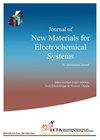Analysis and Optimization of the Performance of Hydrogenated Amorphous Silicon Solar Cell
IF 0.6
4区 材料科学
Q4 ELECTROCHEMISTRY
Journal of New Materials For Electrochemical Systems
Pub Date : 2021-09-30
DOI:10.14447/jnmes.v24i3.a02
引用次数: 0
Abstract
As the name implies, hydrogenated amorphous silicon (a-Si: H) is composed of silicon atoms which are in a disordered configuration away from all Bravais lattices. The hydrogenated amorphous silicon was manufactured in 1969 where there was a renewed interest in non-hydrogenated amorphous silicon. The use of hydrogenated amorphous silicon as the active material in solar cells inefficient but cheap, is currently much studied. We have presented in this work, the results of the numerical simulation of a-Si: H solar cell by the wxAMPS (Analysis of Microelectronic and Photonic Structures) software and the results were compared with those found experimentally, we find a good agreement. For the efficiency there was a difference of 0.17%. We also study the influence of the thickness of a-Si: H intrinsic layer on the photovoltaic parameters of the solar cell. This allows considering the use of amorphous thinner layers for photovoltaic applications. The efficiency has a maximum value of 7.117 %, corresponding to a intrinsic layer thickness of 560 nm. The using a-Si:H alloys provide a good solution to enhance a-Si:H solar cell performance. The use of a-SiC:H as a p-type window layer in amorphous silicon solar cells is one of its primary photovoltaic applications. The wide band gap of p-a-SiC:H alloy used as window layer for minimizing the optical loss. To improve the efficiency of a-Si:H solar cell, we have study by simulation the performance of the (p) a-SiC:H/(i) a-Si:H/ (n) a-Si:H heterojunction solar cell. The effects of a-SiC:H window layer on the photovoltaic performance have been investigated, where the best initial conversion efficiency of 10.59%.氢化非晶硅太阳能电池性能分析与优化
顾名思义,氢化非晶硅(a- si: H)是由远离所有Bravais晶格的无序构型的硅原子组成的。氢化非晶硅是在1969年制造出来的,当时人们对非氢化非晶硅重新产生了兴趣。利用氢化非晶硅作为太阳能电池的活性材料,效率低但价格便宜,目前研究较多。本文用wxAMPS (Analysis of Microelectronic and Photonic Structures)软件对a- si: H太阳能电池进行了数值模拟,并与实验结果进行了比较,发现两者吻合较好。效率差异为0.17%。我们还研究了a-Si: H本征层厚度对太阳能电池光伏参数的影响。这允许考虑在光伏应用中使用非晶薄层。效率最大值为7.117%,对应的本征层厚度为560nm。采用a- si:H合金为提高a- si:H太阳能电池的性能提供了良好的解决方案。在非晶硅太阳能电池中使用a- sic:H作为p型窗口层是其主要的光伏应用之一。利用p-a-SiC:H合金的宽带隙作为窗口层,最大限度地减少了光学损耗。为了提高a-Si:H太阳能电池的效率,我们通过模拟研究了(p) a-SiC:H/(i) a-Si:H/ (n) a-Si:H异质结太阳能电池的性能。研究了a-SiC:H窗口层对光伏性能的影响,其中最佳初始转换效率为10.59%。
本文章由计算机程序翻译,如有差异,请以英文原文为准。
求助全文
约1分钟内获得全文
求助全文
来源期刊

Journal of New Materials For Electrochemical Systems
ELECTROCHEMISTRY-MATERIALS SCIENCE, MULTIDISCIPLINARY
CiteScore
1.90
自引率
0.00%
发文量
33
审稿时长
>12 weeks
期刊介绍:
This international Journal is intended for the publication of original work, both analytical and experimental, and of reviews and commercial aspects related to the field of New Materials for Electrochemical Systems. The emphasis will be on research both of a fundamental and an applied nature in various aspects of the development of new materials in electrochemical systems.
 求助内容:
求助内容: 应助结果提醒方式:
应助结果提醒方式:


